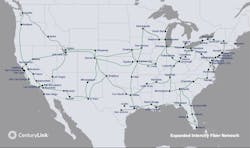CenturyLink taps Corning for 4.7 million miles of intercity fiber
CenturyLink, Inc.(NYSE: CTL) is utilizing its global multi-conduit infrastructure to expand the provider's intercity network by 4.7 million miles of fiber, making it the largest ultra-low-loss fiber network in North America, the company claims. The first phase of this overbuild fiber installation, completed in June, connects more than 50 major cities throughout the U.S. and comprises a purpose-built long-haul network and dense metro networks designed to stay ahead of growing data demand.
The project uses Corning Incorporated's (NYSE: GLW) SMF-28 ULL fiber and SMF-28 Ultra fiber in a hybrid Corning SST-UltraRibbon cable. With a silica core design, SMF-28 ULL fiber offers the lowest loss of any terrestrial-grade optical fiber, claims the company, and will provide the CenturyLink network with a boost in optical signal-to-noise ratio (OSNR) which can extend optical reach at very high data rates. The added capacity will further improve the scalability of the network to meet the high bandwidth demands of emerging technologies and applications such as 5G, augmented reality, high-definition video streaming and the Internet of Things.
The second phase of the CenturyLink network expansion will include areas in Europe and will be completed by early 2021. The expanded infrastructure, using the latest optical innovations from Corning, will enhance performance levels across CenturyLink’s network, benefiting businesses, government agencies and providers seeking fiber to build their own secure, scalable networks for demanding next-generation applications.
“As customer demand for extreme high-capacity, low-latency data transport continues to grow, our newly-built intercity fiber network, created with the latest optical technology, is another example of how our diverse fiber assets differentiate us from other network providers,” comments Andrew Dugan, CenturyLink chief technology officer. “Our multi-conduit infrastructure has a significant amount of capacity for supporting the growing demand for fiber and will allow us to quickly and cost effectively deploy new fiber technology now and in the future. This uniquely positions CenturyLink to meet the needs of companies seeking highly reliable, low-latency network infrastructure designed to move massive amounts of data.”
CenturyLink said it was able to quickly and cost effectively complete the first phase of the project using multi-conduit infrastructure already in place. The company is currently selling routes to large enterprise companies and content providers in the U.S. and will work with customers to add additional routes as needed.
“A next-generation network requires next-generation optical infrastructure, and we believe Corning's fiber and cable innovations will enable CenturyLink and its customers to unlock the opportunities presented by the Internet of Things and other transformative technologies," concludes Dr. Bernhard Deutsch, vice president and general manager, Corning Optical Fiber and Cable. "With the expanded optical reach and capacity provided by our ultra-low-loss fiber, CenturyLink will magnify the capabilities of their expansive, scalable fiber network.”
